
|
|
|
Search our site
Check these out    Do you have an entertaining or useful blog or personal website? If you'd like to see it listed here, send the URL to leon@pawneerock.org. AnnouncementsGive us your Pawnee Rock news, and we'll spread the word. |
Too Long in the WindWarning: The following contains opinions and ideas. Some memories may be accurate. -- Leon Unruh. Send comments to Leon November 2007Colorful Pawnee Rock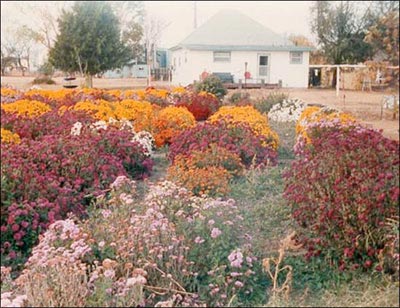
Burl Schell's home flowerbed. Burl took this photo in 1991, and Virgil Smith shared it with us. [November 30] I was greatly surprised to open an e-mail from Virgil Smith earlier this week and find the photos of the mums. When I was living in our hometown, I don't remember ever seeing such floral exuberance in public. Certainly, Pawnee Rock had a few green thumbs with flower gardens, and the school had a row of tiger lilies that exploded into orange late in the spring. Lilacs in the dooryards bloomed, and there were peonies for spring holidays. Roses climbed trellises along clapboard houses. But a public flowerbed was beyond us. True, the town's landscape and people changed, and when I was growing up the lumberyard occupied the land where this flowerbed sprawls so luxuriously in 1991. I'm glad Burl Schell and others found it in their hearts and pocketbooks to plant the mum garden. I'm also grateful that Burl took the photos and shared them with Virgil. It's a good project that deserves a lot of praise. Nursing homes and hospitals: In the course of putting together yesterday's newspaper, I came across a story about dangerous nursing homes. The Medicare office of the Department of Health and Human Services has a comparison of nursing homes. I compared the ones within 50 miles of Great Bend and saw a bit of variation in nursing quality, patient care, and fire safety -- but no dangerous nursing homes. Here's the nursing home page so you can check out the ones in your area. Here's the page for comparing hospitals. Now it really is the Border War: My friend Mary Steiert, who attended the University of Missouri, thought I needed little cheering up after the Tigers upended the Jayhawks in football, so she asked: "Why do KU grads hang their diplomas from their rearview mirrors? . . . So they can park in the handicapped spaces." Downtown with Leon Miller[November 29] Leon Miller, who was in high school when yesterday's parade photo was taken in 1948, wrote about downtown Pawnee Rock:
The building to the left, or south of D & B, had some sort of fix-it or repair shop in it in the late '30s and early '40s. I remember taking an electric train engine to the owner to get it repaired sometime around the start of the war. I think both of the banks failed after the stock market crash of 1929, aided on by the Dust Bowl and Great Depression. If it hadn't been for the Crash, Pawnee Rock might have rivaled Larned for size and development. There were many entrepenuers who planted their seeds there. How smart are you? I used to think I had the world figured out. Then, in a news wire story that started out about along the lines of "Most schoolchildren can't tell Kyrgyzstan from Kansas," I found a really good geography test. When I was given a country name and asked to find it on a map without words, I didn't do nearly as well as I expected to. See how you do on the Geography Zone quiz. And after you've proven yourself the king of maps, test your vocabulary. Peg Britton from Ellsworth sent me the Free Rice link a couple of weeks ago, and then yesterday I heard it discussed on public radio. It made me smarter: Free Rice Thin-carpet religion
1981 budget for Bergthal Mennonite Church. [November 28] Our church had a thin carpet, not threadbare but not plush. It was meant to last a long time. In fact, our whole church was the same way. Built in 1915, it has sturdy brick walls and strong woodwork around the windows. The pews are as hard today as they ever were. The lights hang from the ceiling on long cables. Our church, like the other churches in Pawnee Rock, made do on a small income. In 1981, which happens to be the year's budget I have at hand, the church planned to spend $21,900. More than half of that was the preacher's pay and car allowance.
I've been reading with interest this month about Oral Roberts University, a ministry-oriented campus in Tulsa, and its financial and moral troubles. The ministry/church president and his wife misused ministry/church property and money and often strayed beyond moral rectitude. Or so the lawsuit against them says. On Tuesday, the regents accepted his resignation. ORU split the university off from the Robertses' ministry. And an Oklahoma businessman said he'd give ORU $70 million to help get it out of its $50 million debt. Considering inflation since 1981, $50,000,000 is 967 times the 1981 budget of the Bergthal Mennonite Church. Imagine: Oral Roberts University could bankrupt 967 churches the size of Pawnee Rock's Mennonite Church. Imagine how many families scraped a few dollars out of their checking accounts to donate to Oral Roberts after hearing his pyramid-scheme promise that sending money to God through Oral and Richard would persuade God to make the donor rich. How many families does it take to build up a church and school to the point where it can squander and steal itself $50 million into debt? Back in the mid-1980s, when I lived in Wichita, a friend and I drove down to Norman for a basketball game. On the way back that Sunday, we stopped in Tulsa on an errand, and for kicks we trundled around the ORU campus. We admired the spiky Prayer Tower and then headed for the glossy tower where the ORU hospital officials worked. We rode the elevator to the top floor to get a good view and stepped out onto the plushest carpet I have ever admired. Each roomful of furniture looked more expensive than the home where I grew up. The churches of Pawnee Rock are not palaces. They were built and operated with money raised by the people who worshipped there, and enough money is found each year to send some off for church colleges, missions, and emergency aid after disasters. You can take or leave faith as you choose; the donation-driven ministries of television and radio seem to have made their choice. In the small churches of the Plains, however, the members and ministers aren't in it for the money. Henry Svatos: After seeing the photo yesterday of the Lindas Lumber Co. staff, Richard Batchman wrote: "Henry Svatos was my great grandfather and managed the lumber yard in Pawnee Rock for many years. He built the house on Flora Ave. where I think Keller lives now (second house from the west on the south side). And I have heard stories about how he liked his beer." Back doors of history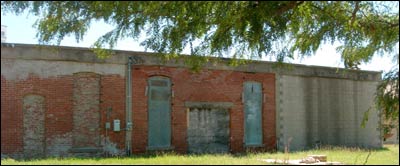
The back of the 1908 Lindas building in 2006. 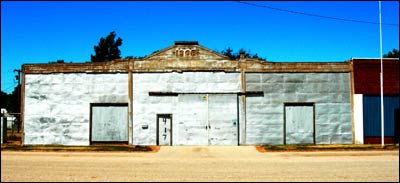 The front of the 1908 Lindas building. [November 27] As I grew up in Pawnee Rock, I knew the doors and windows were there in the back of the 1908 building on Centre Street, but my upbringing kept me from investigating too closely the mysteries of other people's property. What we see now are doors and windows that have been blocked off to keep out vandals, but the back of the building must once have been a busy place as wagons and trucks brought in and took away lumber and household goods. In the 1920s, every lot along Centre Street's west side was filled with a shop, store, office, restaurant, or bank. A couple of them were made of brick, and the rest were wood. Imagine the sounds and smells that greeted someone strolling down the dirt alley in 1914. In the Depression years, at least one frame structure stood behind the Lindas building, about where a honey locust now grows along the alley. Wouldn't it be fun to go back in time just for a day to see what old Pawnee Rock was like? Imagine how that would influence the way we look at the town today. Those Schultz nieces: Larry Smith, who grew on the northwest corner of Houck and Cunnife, writes of the recent "Schultz nieces and nephews" picture: "Third from the left looks like Gladys Delaplane that lived three houses down the street from us on the opposite side." Trading cards and dreams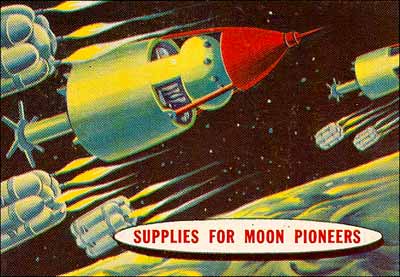
[November 26] Lots of us have collected trading cards: baseball, auto racing, basketball, football, Iraqi leaders, and so forth. Gathering them has been a pastime for a hundred years. The world of cards has changed, however, and I don't think it's for the better. Collecting seems to have gone from an excuse to know the game to an exercise in industrial drudgery. Families buy and set aside whole boxes of cards in hopes that a no-name player will become a star and make his card so valuable that it can be sold for $20 on eBay. But once in a while, somebody digging through their childhood things will find a stack of trading cards. Maybe it's two dozen baseball cards wrapped in a rubber band, or a nearly complete set of Monkees cards, or even a few space cards. Forty years ago, spacecraft were being launched at the moon. What would it be like to live on the moon? How would supplies get there? Artists and scientists combined to show us by producing a series of space cards. Science fiction became all the rage as humans tried to sort out the moral possibilities, but it seems clear now that reality was catching up with our imaginations. Space cards never outsold baseball cards, of course -- you would have to search a long time to find a card set of space shuttle crews -- but they are much more valuable as a token from the days when kids in the middle of the continent believed the heavens were ours for the taking. 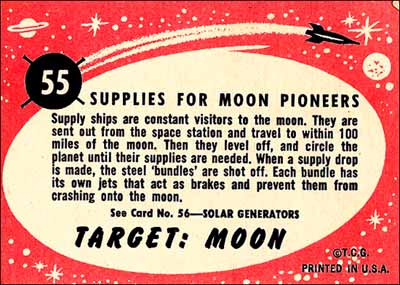
The man who let light shine in
This composite photo, made in 2005, shows how much difference it makes when the undergrowth was trimmed out of the wooded area. [November 25] Jerry Allen wrote about yesterday's photo of the woods south of Santa Fe Avenue. "The pic of the house across the street is where my father-in-law lived (one of Art Sayler's houses). I am the guy who cleared a lot of the trees out when I lived in Pawnee Rock. My sister-in-law lives in the house now. "When I would go over to the property to clear trees, I would see Elgie in his yard and I would go across the street and visit with your dad. Sometimes I would go to Elgie's shop on the corner by the evelator and visit with him as he was doing some project. I will always consider your dad as one of my friends. Thanks for the note, Jerry. It's good to hear from you. I had long wondered who had the grit to do all the sawing and chopping and other backbreaking work involved in opening up the forest. Big game, big stadium[November 25] Back in 1972 when I was in the Argonne Rebels, we were the halftime entertainment at one of the Kansas City Chiefs' first games at Arrowhead Stadium. Before and after our show on the field, we sat in the rounded end of the stadium, close enough to the field to see the cheerleaders' smiles. The year before, we played for a game in the doomed Municipal Stadium in KC, so moving up to Arrowhead was quite a treat. There were more more than twice as many people in Arrowhead for that one game as there were living in Barton County. It's easy to remember those two evenings (and two similar days at Mile-High Stadium in Denver). For this high schooler, it was a classic case of country boy goes to the big city and performs in the stadiums where his heroes since fourth grade had played. And so, as I sat in from of the TV last night, it was easy to imagine myself in the cleated shoes of the Kansas Jayhawks as they played Missouri in Arrowhead.
The mystery of how good KU's football team really is finally has been solved. It's almost as good as Missouri's. Nevertheless, this is KU's once-in-a-lifetime season. I don't think we can expect KU to pull off the same thing next year, but I'll be glad if it happens. Maybe the Joy Hawks will linger for another couple of good seasons, like K-State did, before becoming mediocre again. At this point, I feel obligated to say that we have to keep the KU-MU game in perspective and remember that football isn't everything. (Basketball is.) On a different note, I am still perplexed by the purported archrivalry between KU and MU. For me and my friends at KU, the Big Games occurred against K-State (plus Kentucky in basketball). A key piece of the rivalry is that Jayhawks and Wildcats fans had to live with each other all year, so neither side could gloat or whine too much over what happened on a campus in eastern Kansas. In fairness, maybe hard feelings linger more among those who grew up along the Missouri border and among those who enjoy whipping themselves into a frenzy over distantly historical events; the second method of behavior is expressed also in the Balkans and Middle East. For most of us who have lived in Pawnee Rock and central Kansas, our perspective generally reaches back to the white settlement of the Plains after the Civil War. Although our state was born in Civil War times, we paid little attention to Blue-Gray hatreds. Our Kansas is where the New America began. (I'm not a complete fuddy-duddy. I want one of those sweatshirts bearing the motto: "Kansas: Protecting America from Missouri since 1854.") The "Border War" is the sanitized marketing of atrocities from the Bleeding Kansas days. If you want an up-to-date interstate rivalry opponent, why not look at Colorado, which has been locking up the Arkansas River's water for decades? And why shouldn't Oklahoma hate Kansas' guts for the Oklahoma City bombing? If sports is going to be any fun, we should keep it as simple as trying to clobber the teams that beat us last year. That way, we can always enjoy playing in the big stadium. A photo I like: No. 62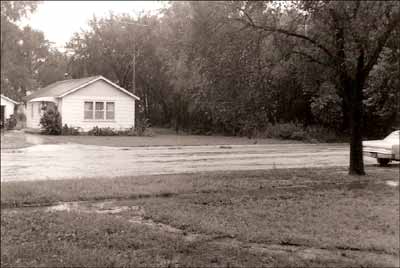 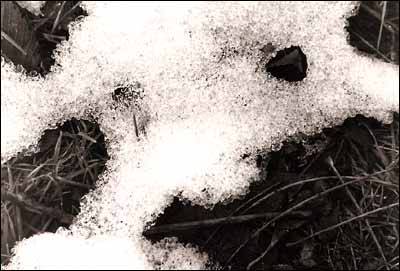 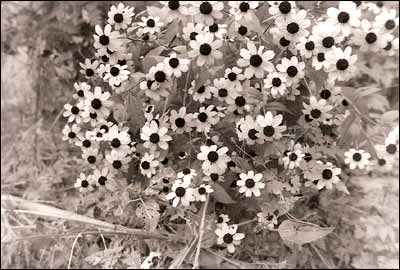
[November 24] When I was in junior high, my mom introduced me to 35mm photography. I walked around our house day after day, cradling the Argus and focusing the rangefinder on everything. Mom staked me to a few rolls of Tri-X, the standard high-speed black and white film of the day. (In fact, she paid for a lot of film and developing at Meller's, a photo kiosk along 10th Street in Great Bend.) I took hundreds of photos that don't have any artistic value, although each was a treasure to me then. But I was starting to see things: how colors separated flowers from the background, even in black and white; the way snow melted down around a rock; the million splashes brought by rain. I was fortunate that Mom didn't make me take only "good shots." She let me discover things on my own and in books. And now I have, among many other things, a record of what our street looked like in the rain, back when the woods across the street were a dense forest. The car at the Tutak's house next door was angular, Santa Fe Avenue was covered in sand but freshly curbed, the place across the street was neatly kept, and our lawn needed to be mowed. It was a quick photo that gains value every year. The Pawnee Rock correspondent
[November 23] The Larned Tiller and Toiler kept its circulation around 3,000 for many years by maintaining a network of women in towns around Larned who would collect the week's local news and pass it on to the paper. Their thick envelopes -- handwritten dispatches on a dozen sheets of stationery -- would be typeset carefully by Loretha Huxman as she did her best to read their writing. Pawnee Rock's correspondent for a number of years was Ella Foster. She would call around town, following tips that somebody had gone somewhere or had had somebody over for a meal or had gotten some scholarly honor. Some families were mentioned far more often than others, and some families were not mentioned at all even over the course of a year. Neighbors, schoolmates, and relatives of the writer -- not just in Mrs. Foster's case, but with all correspondents -- tended to make the newspaper frequently. Some people called Ella with their news; others let town gossip lead Ella to them. A lot of people, I suspect, were not publicity hounds but simply wanted an important or happy piece of their life on the record. The Tiller performed a great service for Rozel, Zook, Ash Valley and a half-dozen other communities at the cost of a free subscription or a few dollars paid to the correspondents. In return, locals had a reason to subscribe to the Tiller and to buy extra copies when their family was mentioned. The writing is not fancy and sometimes misses punctuation, yet it is beautiful for its direct style and the weaving in of family ties. It's a record of life in our town during a week, one more page of history and accomplishment. Here are excerpts from the Tiller and Toiler of April 9, 1982: Laundry Mat closes after 15 yearsMrs. Ella Foster, Pawnee Rock correspondent
Mr. and Mrs. Roger Unruh, owners and operators of the Pawnee Rock Laundry Mat for the past nearly 15 years have closed their place of business, as of April 1st. Many residents of Pawnee Rock will miss and regret the closing of the convenient and accommodative place of business. It was so well managed by the Unruhs. Mrs. Alta (French) Rheel of Crete, Nebr., was a house guest in the home of her aunt Ruth French last week. Alta, a retired school teacher spent her high school days in Pawnee Rock graduating in 1925. Alta accompanied her sister Mrs. Louis Weaver (Ruth French) and Mr. Weaver of Coeur D'Alene, Idaho and her brother George French and Mrs. French from Kalispell, Montana to Pawnee Rock. Earl and Janice Schmidt and Helen Deckert were called to Mesa, Arizona Sunday March 28th due to the sudden death of their brother Edward, death occured Saturday March 27th. Memorial services were held on Tuesday March 30th in Mesa. Edward the son of the late Mr. and Mrs. H.D. Schmidt was born and raised in the Pawnee rock Community, attended Pawnee Rock schools, service in the Merchant Marines, became a skilled Radio and Television Technician and an instructor in rehabilitation training. Union Good Friday service will be held in the Pawnee Rock Christian Church at 7:30 p.m. April 9th. Grace Werner, a resident of the Great Bend Manor had the misfortune of falling and breaking her hip last Tuesday, March 30th she underwent surgery Wednesday morning March 31st. Ina McMillan and Fred Fry are her niece and nephew. The engagement of Todd Schmidt and Kenda Halling has been announced by their parents Mr. and Mrs. Jarold Schmidt of Larned and Mrs. Virginia Smith of Dodge City. The wedding is planned for April 17th. The Jarold Schmidts are formerly Pawnee Rock residents. Todd is the grandson of Fred and Velma (Schultz) Schmidt, Pawnee Rock. Glennis Lile Miller, Larned, visited her aunt, Ruth French, and the visiting cousins from Nebraska, Idaho and Montana last Wednesday. Tops KS 512 Tops KS 512 met April 1 at 6:30 p.m. at the Depot Community Center. Eleven members were present. Best loser for the week was Mary Flick with 9 lbs lost. East White was co-loser with 3/4 lbs. Our new officers for 1982 and 1983 are: Doris Tutak, leader; Lola Clark, co-leader; Easter White, secretary; Barbara Manka, treasurer; Betty Navaro, weight-recorder; Mary Flick assistant recorder. Dinner guests in the home of Janice and Earl Schmidt on Sunday April 4th were Mr. and mrs. Calvin Drake of Tulsa, Okla., Mr. and Mrs. James Rainbolt, Gary and Kale, Mr. and Mrs. Randy Rainbolt and Jim Bob, Mr. and Mrs. Chester Unruh, Mr. and Mrs. Bob Keast and Tyson, Mr. and Mrs. Max Mohler, Mr. and Mrs. Chester Junior Unruh and Mrs. Ellis Flick all of Larned. Arthur Flick of Lewis, Mr. and Mrs. Douglas Flick and Ryan of Great Bend and Mr. and Mrs. Tom Flick of Pawnee Rock. Mr. and Mrs. Eldon French hosted a dinner honoring the birthday of their son, Terry French. Mandy Myers, daughter of Walter and Jacepine (Smith) Myers of Pawnee Rock is listed among the Seniors honored at the annual University of Kansas alumni association Honor Banquet held Wednesday night March 31st at the Harvest Inn in Larned. Mrs. Elgie Unruh (Anita) of Pawnee Rock is listed among the area residents to be honored at Wichita State University's annual honors convocation on April 4. Mrs. Percy Converse, Mrs. Cecil Pfister and Keith Converse were in Hutchinson Sunday April 4th visiting Mrs. Darrell A. Drake and Mr. and Mrs. Darrell G. Drake and Rebecca; they were joined there by Mr. and Mrs. Harold Willmeth of Salina. A sip of good humor[November 22] Grownups, if you'll allow me a generalization, have in common a gross susceptibility to compliments. Tell a man or a woman that he or she looks great in a particular hairstyle, and you might find your friend still sporting a mullet, for example, two decades after that hairdo went out of style. But tell a man you like one of his jokes, and he'll assume that you, being a perceptive judge of humor, will want to hear that joke again and again. And again. Someday my sons will work up the nerve to tell me to stop saying, "The train just went by here. It left its tracks." They stopped laughing years ago, but the joke lives on. The joke was a gift to me from the Santa Fe and my dad. 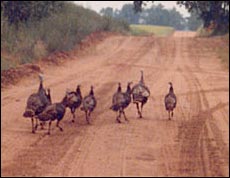
My dad, Elgie, has his jokes. (Maybe all men have just six or seven.) During Thanksgiving, we were unable to get through a turkey meal without his saying something like, "Did you have Wild Turkey?" followed by a grin and nudge. The best I can figure out, that was funny back in the days when nobody, especially Mennonites, drank out loud in Pawnee Rock. Perhaps the joke was honed at Lions Club meetings or at the pitch games in the elevator office basement. And then in the 1980s wild turkeys themselves were let loose to breed in the farmlands and Arkansas River bottomland around Pawnee Rock, and pretty soon they were almost as common along the sandy roads as the similarly resurgent whitetails. Whenever we saw the turkeys, Dad brought out his joke out again. I think my wife -- whose hair is lovely no matter how she styles it -- would put the lid on me if I started talking about Wild Turkey around our sons. In that event, I'd have only one response: "Yes, deer." Now, everybody, let's wash our hands and get to the turkey! Joke about it at your own risk. Of Thanksgiving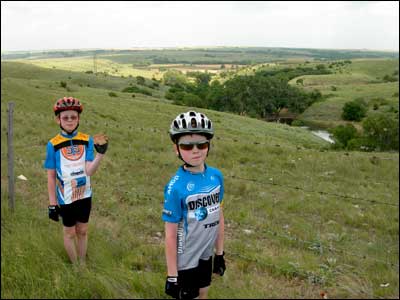
We were thankful for a pretty state to bike across. [November 21] This time of year always puts me in the mood for silly black-paper hats with buckles and turkeys made of construction paper shaped like a first-grader's hand. I'm fresh out of first-graders, so perhaps you and I could instead just think about how much fun we've had with simple things . . . and then we could hug a kid. Thanksgiving is a happy holiday, when we lean back and celebrate the hills we have climbed and the good things that have fallen our way during the past year. It's the start of a grace period, too: We don't have to think about how we'll do better next year until we make resolutions at the end of December. As always, I am thankful you have joined me on PawneeRock.org. I could rattle on by myself day after day, but it is your guidance, recollections, and photographs that make this site about our hometown enriching for all of us. I am thankful for a good year in sports: KU basketball is good again, K-State basketball shows promise, Macksville High won the football championship, and (as you've probably heard until you're sick of it) the KU football team has a decent chance at the national championship. I hope the Hawks get it, although I'm pretty sure that doing so would make the Earth spin backward. I am thankful for a family that is smarter, funnier, kinder, brighter, more inquisitive, and better at carpentry than I am. My friends are all that way too. I am thankful I got to guide our sons across the state in Biking Across Kansas (and grateful that my wife accompanied us in an RV). They got an eyeful of Kansas and found strength in themselves. I am thankful simply for having lived through the past year. I hold high hopes for the next one too. I wish you all a future of pleasure and good health. Houses of a kind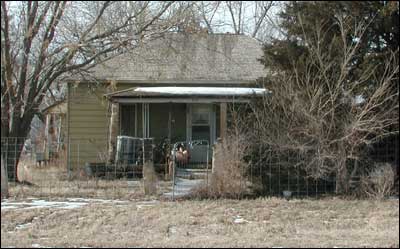
House on the northeast corner of the old grade-school block. 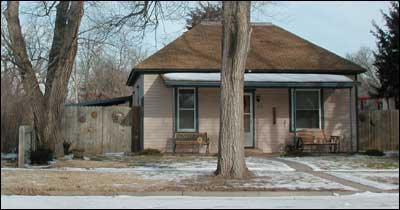
The former Tutak family home on Santa Fe Avenue. [November 20] Don Ross wrote to say he didn't know what happened to the Edd and Opal Cooper Williams house mentioned yesterday, but he had an idea. "After the old grade school was torn down, Stanley Tutak moved some houses onto those lots and this Williams house could have been one of them. Lester Zieber and his family lived in the Williams house before they moved across the street into his father's house." Don raises an interesting point. The school was used until the mid-1950s, and that's why that block generally has houses that look newer than the ones around them. The block where the old grade school stood is the one where Merita and Milton Rice live, between Santa Fe and Bismark avenues and Rock and Houck streets. On the northeast corner of that block is a house similar to the Williamses' house; I think the Lohrs used to own it. Maybe it was moved there. And Tutak himself had a similar house for his own family, but I don't know how it came to be there. That house sits a half-block east of the old school block on Santa Fe. (Now I see that house shape everywhere. I grew up next to the Tutaks, so I'm surprised I didn't make the connection myself.) As for the Zieber house, it lasted until late in the 20th century, when it fell into disuse and was removed. The photo below shows the property with the weed-filled foundation and a concrete-block outbuilding. 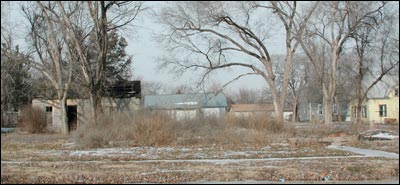
The old Williams house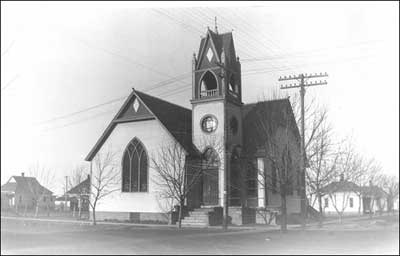
[November 19] A couple of weeks ago, we saw a photo of centenarian Velda Pfister, Kay Steed and Sandra Harris. Kay later wrote to Velda to ask about the photo of the Methodist Church that had appeared on PawneeRock.org (it's now in the Gallery.) Here's what Kay sent us: "I received a letter from Velda Pfister and she told me that in the picture of the Methodist Church, on the right side, north and west is the home of Edd, Opal and Delbert Williams. Opal was a Cooper. Velda says that later a two-story parsonage was built between their home and the church." Below, I've put a stitched-together photo that shows most of the south side of Pawnee Avenue in that block, starting with the former Methodist parsonage (known to me as the Kemp home). Next to it is the vacant lot where, if I'm reading Kay's letter right and interpreting the 1914 photo right, the Williamses' house stood -- you may remember the foundation that was there for years -- and then the house owned for so long by Willard and Ruby Wilson. (I'd like to know what happened to the Williamses' house.) Each of the individual photos was shot from a different perspective, so the tree branches and SUV parts don't line up when they're put together, but it should give you a good idea of how the place looked a couple of years ago. 
Bee warned: Virgil Smith was writing about the bee on the homepage thistle photo and added a note about Africanized honeybees at his and Joan's house in the Phoenix area: "I don't know if the Africanized bees have gotten to the Pawnee Rock area, but they have here. One morning several years ago I went out in my back yard and noticed bees landing on the eave of my roof and seeming to find a way into it. I was concerned and found 'Bee Removal' in the yellow pages and called them. They said that they should be removed as soon as possible and they could come out and see what had to be done. "When he came out, he said that they had to assume that the bees had been Africanized and take extra precautions ($). He dressed up like someone from outer space and told us not to come outside. He sprayed the area and cut into the eave. Then, he took pictures with a digital camera and showed us about five honeycombs in the eaves filled with honey. He said that the honey should be removed or it would ruin the walls and needed to be scrubbed and disinfected or it would continue to attract bees ($$). We gave the okay and he took out about fifty pounds of comb and honey -- of course, the spray had ruined it. After he finished, he closed the opening and sealed it and we had to have it re-stuccoed ($$$)." Macksville, town of champions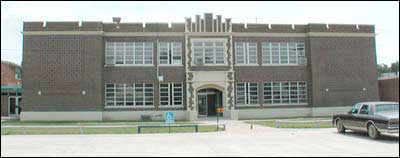
Macksville High School in 2005. [November 18] What a Saturday for football: K-State nearly beat Missouri, Kansas did beat Iowa State, and Macksville High won the large-division eight-man high school championship. In a game played in Newton, the Mustangs spotted Hanover a fourteen-point lead but won 24-20. MHS ended the season with a 13-0 record. It struck me over supper last night how the game was played by the children of the kids I went to school with. So closely were Pawnee Rock and Macksville tied in the 1970s and 1980s that it's likely that several players have grandparents in Pawnee Rock. Football Fridays in Macksville, back in the 1970s when Pawnee Rockers started attending MHS, were more than a game. Once school let out, we students stampeded downtown to Lucy's Sundries or to Pinky's Cafe for burgers and fries. We hung around for a couple of hours, dragging Main and the highway, maybe hitting the grocery store, before going back to the school to put on football or band uniforms. Macksville, in retrospect, must have been a lot like Pawnee Rock was twenty years earlier. In the early 1970s, Macksville had at least one bank, a couple of places to eat (including a soda fountain in the drugstore), a liquor store, and a grocery store. It also had a car museum, a nursing home, the Wegele mower factory, a bandstand in the park, and a city swimming pool. I think that's one reason we Pawnee Rock kids liked Macksville so much. We felt comfortable in the slightly larger Macksville, but there was so much more there than we had at home. We also could try out new teenage personas where our parents couldn't see us. I don't know how Macksville survived better to that point than Pawnee Rock did. Perhaps Pawnee Rock, even with a state park and a nationally known historical trail, suffered from its location between two county seats; shoppers and workers had better options nearby in Larned and Great Bend than they had at our small grocery store, school, elevator, lumberyard, gas station, and carpentry, welding, and car-repair shops. Macksville has St. John, a very nice town, to the east, but nothing to the west, south, or north. The school draws students from a passel of towns and used-to-be towns: Radium, Belpre, Trousdale, Pawnee Rock, Dillwyn, and Hopewell, among others. I think Macksville now has the only high school on U.S. 50 between St. John and Kinsley. The high school's enrollment is shrinking; it used to play 1A eleven-man football and now it's playing eight-man with an enrollment of 76. But the school is the district headquarters, so it's unlikely the school will be closed for decades. And that's probably going to be the lingering salvation of the town. The football championship, by the way, is Macksville High's second state crown. The Mustangs claimed the boys basketball title in 2006. Tammy Ward, big winner: Tammy Ward of Pawnee Rock has won the Kansas Lottery's Open Season game, according to this story on KSAL.com and sent to us by Larry Mix of St. John. Tammy won a four-wheel utility vehicle and trailer, $1,000 cash, and a lifetime hunting and fishing license. A photo I like: No. 61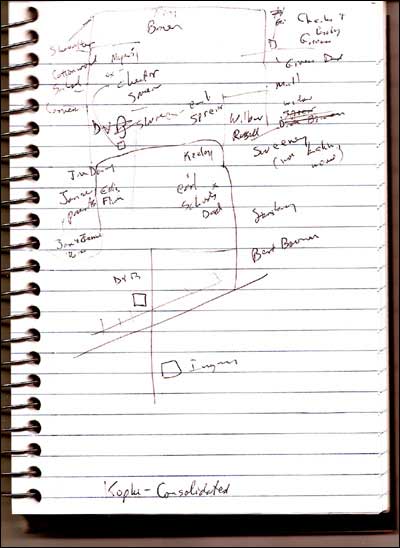
[November 17] This isn't really a photo that I like, but it is a photo of a map. I drew the map while driving around south of Pawnee Rock with my dad a year ago. Elgie Unruh ran a bus route and the mail route for a while, so he knew everybody. In addition, he has lived in the area his entire 81 years. I figured that if I got the chance to find out where everybody lived -- or used to live in that period that only old-timers reminder -- I'd better pay attention this time. The top of the map is south because that's the way we headed out of town, and it's easier to draw "up" in the direction I'm headed. The drawing is not to scale, and my scribble is exacerbated by the fact that I did it while driving. Some of the farmsteads on the map don't exist anymore; Earl Schmidt's dad's home south of town along Ash Creek is one of those places. There are probably a lot of places that didn't make the map that should have. Pawnee Rock faces: Admit it -- you all wonder what all the rest of us look like. I'm glad Leon Miller learned how to run a scanner and took the initiative to send us his high school photo and one from 2005. Now, who's next? Macksville vs. Hanover: The Macksville Mustangs are playing today for the state eight-man football championship at the high school stadium in Newton. The Tribune has a story about the game against Hanover. For you are beautiful[November 16] Last night I hit the wrong button on my radio and landed on a show playing easy-listening classics from the 1970s -- the songs that long ago slid into Muzak's Hall of Fame. Shameless romantic that I am, I kept listening to Judy Collins as I drove through the Army post, the mountains on one side, the rushing saltwater tide not far away on the other. And then came Roger Whittaker's mellow voice singing "The Last Farewell." My friends, I couldn't tell you how many times I heard that romantic/heroic melody in 1972 and 1973. It was inescapable wherever a radio was on, but I heard it mostly in cars as we hurtled past the fields of corn and soybeans to Macksville and back for school. There's a ship lies rigged and ready in the harbor I heard there's a wicked war ablazing Though death and darkness gather all about me Being square kids in the middle of Kansas, we could not have truly pictured the heaving waves or the "fragrance of these islands," nor even a ship in the harbor of a sea we had never seen, but I think we were all moved to make ourselves greater than we were. Were our daydreams in vain? I thought I knew beauty and I wanted to know love, but all teenagers then lived under the cloud of Vietnam. The trips to school may have been the last time I listened to "The Last Farewell" in the company of others. In the few times I've heard it since then -- mostly on song-collection infomercials -- I've thought of those years of boundless energy and craving in Pawnee Rock. Songs like this encouraged us to venture beyond the horizon, and they told us that we'd someday be called home. In the years since I left Kansas, I've smelled the fragrant islands and ridden the cold heaving waves, and I've found beauty and love. As I blush, I wonder: Is it OK to admit out loud that "The Last Farewell" is one of my favorite songs? Tradition is a recipe[November 15] When the newspaper arrived yesterday, I couldn't help but notice all the Thanksgiving food photos and recipes on my way to the comics. What a hoot those recipes are, and a waste. This time of year, everybody already knows exactly what they're going to eat for Thanksgiving. Our families are spoiled 364 days a year. If we're of a mind to do so, we can get fresh kumquats to go with our South American apples and Mexican tomatoes. But my formative years occurred before the worldwide overnight food bazaar opened, and what I was served, I serve. I suspect our family is not the only one that doesn't mess with the Thanksgiving menu. On this holiday, the ritual is the meal itself. For as long as I lived at home, we went to Grandpa and Grandma Unruh's farmhouse for Thanksgiving. Dad, Mom, and his sister and brother (one or both) and their spouses also would be there, and there were six of us kids. The menu was constant, with a frippery here and there. "Now, you try some of this," Aunt Merle would say in her northwestern Kansas voice when she brought a new side dish. She wasn't going to change any adult minds about what the meal should be, so we kids ended up as the taste testers. (It usually was good.) Thanksgiving was the only day of the year when we had a roasted turkey. Thanksgiving and Christmas might have been the only days we had pumpkin pie (Thanksgiving) or pecan pie (Christmas) or mincemeat pie (no thanks). Those were, thank goodness, also the only days we had green bean casserole (string beans with mushroom soup and canned onion rings). There were mashed potatoes. The potatoes had been peeled clean and the cooked version didn't have any lumps. They also didn't have any fancy spirit -- no garlic or parsley or other contrivances. We had a choice of white gravy or brown gravy; I almost always poured white into the ladle-formed crater atop my mountain of potatoes. Grandma made the rolls. The aunts made other dishes, which usually involved combinations of macaroni, peas, mayonnaise, raisins, green and red Jell-O, and Miracle Whip. I kept my eyes open for my favorite dish: carrot Jell-O. And you couldn't park the cranberry sauce or relish tray too close: olives, celery, carrots, cauliflower, and sweet pickles. Every other year, one of the families would bring a fruitcake that apparently had been received as a gift. Oh, I loved that fruitcake: the pecans, the citron, the candied fruit, the raisins. I know it's trendy to make fun of fruitcake, but for me it's a ticket back to Pawnee Rock on Thanksgiving and the menu that never changed. But maybe somewhere there's a family that doesn't have our Pawnee Rock background, or one that just wants to fill the table in a new family or in a new land. I hope they find the perfect recipe in the newspaper and prepare it so often that their children's children will one day write about it with an soft ache in their hearts. Our military neighbors: Ray Randolph wrote a generous note about the November 13 posting, "The sound of thunder." "Well said, Leon. A 'stopper and thinker.' Puts a more human face on the war over there. Thank you. And may all of us thank those who go in harm's way." Yes, let's remember those who serve on the blunt edge of our country's foreign policy. You know they would rather be back here, and the least we can do is share a little kindness with their families. Art Miller's house: Following up on his note yesterday, I asked Leon Miller about where his grandfather lived when he got flooded in 1921. He replied: "The house I referred to as the Benjamin P. Unruh house was on the corner of the street leading to the Rock. Sonny and Dorothy Bowman lived in it for years and I think their son Brent grew up there. "My grandparents and dad lived in the house just west of that one. "I don't know when they started referring to the street with the various names. Whenever someone came to town and asked where so and so lived we just said, 'Go three blocks north, turn left and its the third house on the south side of the street.' Very sophisticated description of directions." "Echoes of Pawnee Rock"[November 14, part 2] A gentleman named Ralph Bradley has found a copy of "Echoes of Pawnee Rock." He'd like to find a good home for it: "I buy and sell books and have come across a small paperback book by the above title, compiled by Margaret Perkins, copyright Oct. 1908, by the Woman's Kansas Day Club. It appears to contain poems and stories by Kansas writers of that time. If you can direct me to someone or a group that would appreciate it, I would send it to them. I spent several years in Hanston and have an affection for that wide-open country." If you're the appreciative person who would get some use out of "Echoes," tell me and I'll pass your note on to Ralph. Flood in Pawnee Rock: Leon Miller wrote: "You mentioned the story about the storm that produced a record flood in the north side of Pawnee Rock in the 1920s; the Art Miller house noted in the story was that of my grandfather and father. They lived just west of the Benjamin P. Unruh house." Chasing the light: Cheryl Unruh, Pawnee Rock's expatriate columnist, is sad to see the sun set on autumn. Stop that itch!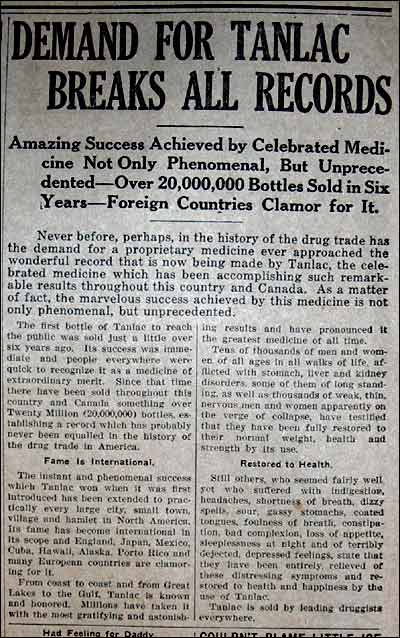
[November 14] So you thought your life was miserable, back there in 1921. If you're not beset by dysentery, it's tetter (eczema, herpes, or ringworm). Your appetite is OK, but maybe you'd be happier moving things along with Force Tonic (it never nauseates). Maybe you're just taking the right medicine yet. Heaven knows, our ancestors weren't in 1921. Page 2 of The Pawnee Rock Herald of August 18 carried several display ads -- and a few ads written into the columns -- for patent medicines.  The killer disease cholera, according to one ad, can be cured with Wakefield's Blackberry Balsam. Need to ward off unspecified deadly diseases as well as nervousness? Take Haarlem Oil capsules. At first I was surprised to see these products available fifteen years after the creation of the Food and Drug Administration, but then I realized that today's herbal miracles and cough syrups may be no better and are hardly more regulated. Eczema, tetter and many other skin troubles are du to disordered blood. If you are afflicted with skin trouble, don't suffer the maddening torture longer, but start right away to purify your blood with S. S. S. -- the standard blood purifier for over 50 years. For Special Booklet or for individual advice, without charge, write Chief Medical Advisor, S.S.S. Co., Dep't 430, Atlanta, Ga. Get S.S.S. at your druggist. Wakefield's Blackberry Balsam has been the surest and quickest remedy for Diarrhoea, Dysentery, Cholera Infantum and Cholera Morbus for 76 years. While it is quick and positive in its action, it is harmless and does not constipate. It checks the trouble and puts the stomach and bowels in their natural, regular condition. Of the millions of bottles sold, no case has been reported where a cure was not effected when directions were followed. Every home should have a bottle or more on hand ready for sudden attacks. 50c and $1.00. $1.00 bottle holds 3 times 50c size. Sold everywhere. take FORCE, the Master Rebuilder. This wonderful tonic is a refreshing appetizer and ready aid to digestion, because of its tendency to strengthen and increase the functional activity of the stomach. Its pleasing stimulation produces a normal flow of the gastric juices, aiding the stomach to properly assimilate and easily digest the food taken into it. Besides, FORCE is agreeable to the most delicate system. It never nauseates. FORCE is sold by reliable druggists everywhere, and is equally beneficial to men, women and children. Aches, pains, nervousness, difficulty in urinating, often mean serious disorders. The world's standard remedy for kidney, livery, bladder and uric acid troubles-- bring quick relief and often ward off deadly diseases. Known as the national remedy of Holland for more than 200 years. All druggists, in three sizes. Look for the name Gold Medal on every box and accept no imitation. Maybe the only reason our ancestors survived is the same reason we do: Grape-Nuts. 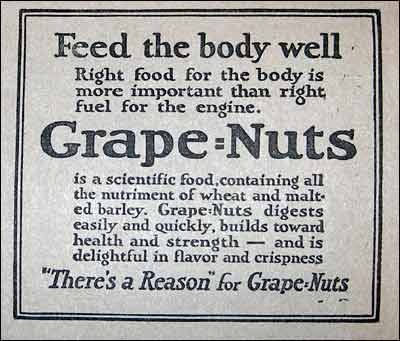
The sound of thunder[November 13] While working on a series of stories about historical cemeteries in 1998, I visited Fort Sill, in southwestern Oklahoma, to see the graves of the Indian chiefs Geronimo and Satanta. Satanta is buried in the campus, but Geronimo lies out a few miles in an Indian cemetery, and that's where I was. On that particular afternoon, the soldiers were practicing with their motorized howitzers, lofting heavy shells into the part of Oklahoma beyond the horizon. I'd hear the delicate and fearful fwt-fwt-fwt of the shell as it drilled through the air above my head, followed at a respectable interval by the sound of thunder. Since that day, I've been a fan of artillery. So it was a pleasure in August to meet the new Army family as they moved in down the block; he's an artilleryman, and he was just back from Afghanistan. Actually, he was based at Fort Hood and was transferred up here shortly after he got back to the States. Their rental house is owned by an Air Force captain and his wife; he flies C-130s and she grew up in Iola, Kansas. A year after he came back from deployment in Uzbekistan, they and their kids were transferred to a base near Little Rock. They rented the place out to an Army sergeant and his wife and daughter; they stayed a year before being transferred to Hawaii, and now he's handling logistics in Kuwait. The artilleryman seems to be a gentle man and a good father. He and his wife have a couple of girls, 10 and 8, and in the evening the girls' bedroom light silhouettes a pair of figure-skating trophies. In September the artilleryman, who had spent some time at Fort Wainwright in Fairbanks and knew his way around Interior Alaska, took their 10-year-old on a caribou hunt. She got one, and I stood in his yard while he sliced meat off the bones and cleaned the flesh off the skulls and antlers and told me how proud he was of his girl. Last Sunday, Veterans Day, as he worked on his big Chevy, I stopped at his driveway to thank him for his service. We got to talking about the climate. He said the snow here was wetter than what he had known in Fairbanks. "You can't do this up there," he said, squeezing a big gloved handful into a snowball. I complimented him for teaching his daughter to use the snowthrower; I had seen them clearing the sidewalk the day before, he walking at her side as she guided the noisy machine. "She's a big girl," he said, "and she can do a lot of things." And as casually as you or I would say we're going to the store, he said, "I'm being deployed to Iraq tomorrow." So soon after getting home? "It's just for nine months, they said," he said, sort of smiling. As I headed home, I searched for something appropriate to give him as a parting thought. "Be careful," I said, with a wave. "I'll try to," he said, with a real smile. I wish I had said, "See you in nine months." Monday morning, there was fresh snow -- the powdery kind the artilleryman knew from Fairbanks. The sidewalk in front of the house was clean but for a trace of powder, and there were small footprints between the tracks of the snowthrower. The artilleryman's house was dark. The block was quiet; the snow absorbed all the sounds. Making news in 1921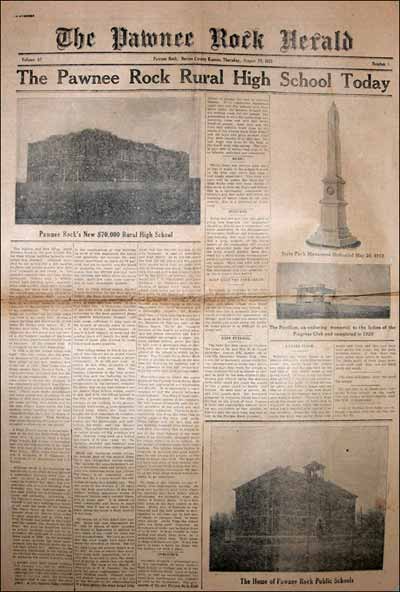
[November 12] The front page of The Pawnee Rock Herald on August 18, 1921, was dedicated to the history of education in town. Timed for the start of the school year, the edition featured photos of the old all-grades school and of the new high school, which had been dedicated the previous January. But that filled only two-thirds of the page. So the editor plugged the rest with the kinds of things one puts on a page one knows will have historical value: photos of the monument and recently (1920) finished pavilion atop the Rock. But even after that, there was more page to fill. So Pete McKechnie or Fred Lobdell, one of whom was then the editor of the weekly Herald, did what newspapermen do, and that was to crank out some more copy to fill the last column's worth of space. Some of what appears was actually news, but there's a lot of padding. The filler starts out with every editor's favorite activity: chiding the readers for a social problem and calling for someone -- someone else -- to do something. Now. What the editor himself should have done is stop writing before he got to the final item. It's as if he completely forgot the prose he so empathically wrote in the second item. Everybody is welcome to the state park, the more the better, picnics, parties of that sort, but it would make things a lot nicer if the watermelon rines, and picnic refuse were taken off the pavillion floor and settees. It would take but a moments time and would add much to the appearance of things. And too some one should mow the weeds and grass along the walks. In some places it is difficult to get along now. The baby boy that came to brighten the home of Mr. and Mrs. H.E. Logan Saturday, August 6th, passed out of this life Saturday, August 13th. Just a wee bit of humanity whose earth life was encompassed in seven days. Seven anxious days they were, for complications from the flu set in almost at once and in spite of the best efforts of physicians and trained nurse the delicate little body could not repel the attack. It was a great shock to family and friends. In their hour of sorrow, Mr. and Mrs. Logan have the tenderest sympathy of everyone whose heart has thrilled to the touch of baby fingers. A brief and appropriate funeral service was conducted by Rev. Allphin, of Kinsley and the little body was laid to rest in the Pawnee Rock cemetery. Probably the worst flood in our history visited the North Side Saturday night. The water filled the streets and came up over the side walk on the east side of the block north of the grand stand. It came down the street west of Benj. P. Unruh's and overflowed most of his yard. It filled the cellar under Art. Miller's house and one site of it caved in. This was about the extent of the damage, but it was a goer while it lasted. There is a ditch along the south part of town that is supposed to carry away the surplus water but it couldn't take care of it on this occasion. Some say this was because the ditch was partly filled with weeds and trash and this may have been partly the cause, but the more probable reason is that there was more water than before to handle. The fields north of town slope down to the trail and they are all listed north and south. Pay your telephone rent -- we need the money. Mr. and Mrs. L.E. Ancel have rented the Wright cottage on the south side and expect to move shortly after the first of September. A lot of Pawnee Rock folks are enjoying a session with the old time enemy, the flu. Football history: How long ago did Kansas have a 10-0 football record? It occurred 4 years before the first flight at Kitty Hawk, 9 years before the Rock became a state park, 13 years before the Titanic sank, and 22 years before the publication of the Herald you just read. Until this weekend, it simply never would have occurred to me to write "the University of Kansas football team, 10-0 and ranked No. 4 in the national AP poll." I might well have believed first that roosters play canasta under my pillow. But there they are, the undefeated Jayhawks, perched atop their bubble. A few years ago, when K-State's football team was profiting from its deal with the devil, I saw car after car with a Wildcat tag, building after small-town building with a Wildcat mural, and rural fenceposts all over the place with purple signs. It's hard to imagine the Sunflower State going gaga for KU football, but maybe if it happens again next season . . . Something needs to be said: Normally I wouldn't bother you with quibbles about Parade magazine, which shows up as part of the fluff inside my Sunday paper and yours. But two things in the November 11 edition need to be corrected. Neither one is about Pawnee Rock or Kansas, but they are relevant to me and possibly to fans of fifth-grade geography. The Ask Marilyn column calls Hawaii the country's westernmost state. In truth, the main Hawaiian Islands are straight south of central and western Alaska. Hawaii has some lesser islands tossed out northwest of the main islands, and they reach nearly to Midway Island. But Alaska's Aleutian Islands go so far west that they continue across 180 degrees east/west longitude, making them the country's easternmost property as well. The other error in Parade appears to be a simplistic attempt to arouse cynicism. In the Intelligence Report column is a headline about "Another Alaskan Boondoogle Bridge." The column says the bridge would cross Knik Arm of Cook Inlet, which is correct, and connect Anchorage with Port McKenzie (pop. 232). Well, that's fine, but it is intentionally misleading to let readers think there's nothing across from 270,000-resident Anchorage but a burg with 232 residents. That's like saying there shouldn't be a highway from Wichita to Hutchinson because the first Reno County town you come to is Haven (pop. 1,173). The sprawling Matanuska-Susitna Borough (borough = county, and it's the size of all of Kansas west of U.S. 281) across from Anchorage is one of the fastest-growing areas in the country, and it has 10,000 residents who live within 20 or so miles of where the bridge would land. The bridge would give them a 20-minute commute to Anchorage instead of an hour's drive around Knik Arm, and it would save northbound tourists an hour on their drive to Denali National Park. Now, the bridge may not be the best possible project or the best way to spend taxpayer money, but it's not the scam that Parade artfully implies it is. Otis Unruh, a veteran[November 10] Otis Unruh, a Pawnee Rock farmer, received his orders to report for a physical examination in August 1918. He was 21 years old, and the Great War in Europe was winding down. 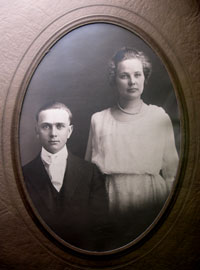 Otis was inducted on September 6. He served as a noncombatant, befitting his Mennonite religion, at Camp Funston near Junction City. He received one furlough to return to the farm for planting. The end of the war came soon -- November 11, 1918 -- and Otis received his honorable discharge on March 16, 1919. His captain, C.R. Ray, wrote of Otis: "Service honest and faithful. No AWOL or absences under G.O. 45. Entitled to travel pay." He was married when he went into the Army, but his wife died in childbirth. In 1920 (see the photo), he married again, to Lena Schultz, and in about 1925 they moved into the house where he had grown up. Otis Unruh died November 13, 1965, and is buried in the Bergthal Mennonite Cemetery. Lena, known as Lena O. (for Otis) Unruh to distinguish her from the other Lena Unruh in the area, died in 1990. Otis was one of many Pawnee Rock men to enlist in or be drafted into the Army for the war. 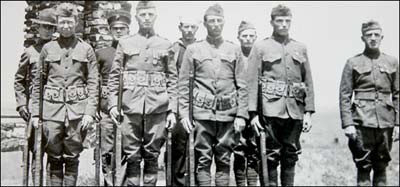
Pawnee Rock soldiers of the World War I era stand on Pawnee Rock, probably early in the 1920s. A photo I like: No. 60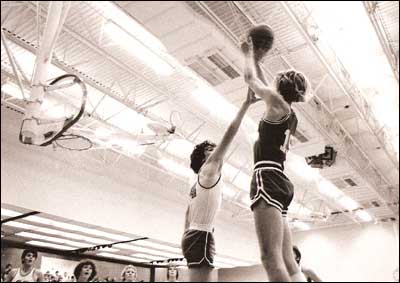
[November 10] I dedicated my last two years of high school to filling the Great Bend Tribune and Larned Tiller and Toiler with stories and photos from Pawnee Rock and Macksville. Every Tuesday and Friday in the winter, I sat on the gym floor and photographed the Macksville High basketball team, which Pawnee Rock boys dominated. This shot, taken at Skyline High west of Pratt in 1974 or 1975, shows Pawnee Rocker Mark "Cotton" Smith making a jump shot. The photo ran in the Tiller the following Monday. Skyline was a real treat for a player and a photographer. Unlike most gyms, it was brightly lit and painted white, which meant that I didn't have to use a flash. I exposed my Tri-X at 3,200 ASA and developed it in Acufine, a strong developer that enabled low-light photography at the cost of much larger grain than usual. It was an exercise in seeing what I could come up with. I figured that if I got a good photo, nobody would notice the grain. Fixated on the fixtures[November 9] Being a gentle child, I was puzzled no end by the urinals affixed to the high school walls next to the drinking fountains. 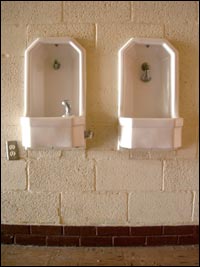 Who on earth would relieve himself out in public? For a long time, I didn't drink out of the fountain half of these installations by the gym because I thought the two fixtures might share some plumbing. I'm sure that everybody else knew all along that the fixture on the right was a spittoon. But that raises the question of what kind of ill-mannered folks were our town's men that they needed to hawk up or spit their chaw cuds so frequently that they couldn't walk down to the bathroom first? And who figured that putting a spittoon next to a drinking fountain was a good idea? Embarrassment aside, having a urinal there might have been more hygenic. No, there are some things I'll never figure out. I suppose that the spittons were put there to avoid having our gentlemen lubricate the floor. For that, I'm grateful. And, if there's a proper name for the fixture and a different purpose, I'd love to hear it and thus banish a childhood fear. Football on the plains: The New York Times has a fine story about the super football team at Smith Center High School. The Redmen have won 51 games in a row and outscored their opponents this year 704-0. Writer Joe Drape says the unifying force is their coach, who is happy enough with a winning record but seems just as interested in making good men out of the boys. Smith Center is about a hundred miles north of Great Bend on U.S. 281, just south of Nebraska. Mud grips, heroes of the road[November 8] Here it is, winter. It's time to put on the mud grips.
I kind of miss mug grips, with their slabs of tread separated by deep canyons so well suited for grabbing sodden soil and central Kansas' damp snow. Put those on a car or pickup, and you can hear that vehicle coming down the blacktop a couple of miles off. But for all their bluster, there was nothing better on the mushy roads north of town when the rainy season arrived. Those pairs of ruts down the center of the section lines were a testament to the mud grips' ability to keep a driver in the safest part of the road. Unruh family reunion: Brenda Jones, a great-granddaughter of P.A.R. and Sarah Unruh, sent this notice of the recent reunion: "The P.A.R. Unruh and Sarah Base (Boese) Unruh reunion was held November 4 at The Peking Garden Restaurant in Larned with 17 in attendance. Those in attendance were: Dwayne and Janis Deckert, Mary Anne Mull, Don and Brenda Jones, Julietha, Sarah and William all from Great Bend, Keith Mull and Marsha Reece from Larned, Glenn and Elaine Mull from Pawnee Rock, Arlene Reece and Teresa Reece from Rozel, Jeanine Haynes from Salina and Vera Spencer and Ben Landwehr from Wichita. "The next reunion will be held November 2, 2008, at The Peking Garden Restaurant in Larned at 12:30 P.M." Evergreen memories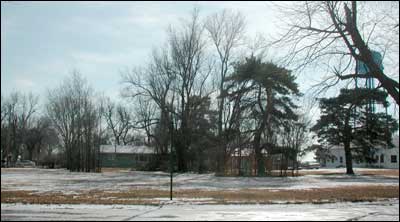 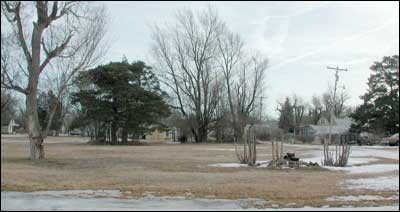
[November 7] The evergreens Virgil Smith wrote about in his ode to Pawnee Rock High School were still standing when I took these photos in January 2005. The top photo of the old school grounds looks south from Pawnee Avenue (the white building is the bus garage), and the second photo looks east from the parking lot of the most recent school's parking lot. In the second photo, you can see the top of Virgil and Joan's former house -- the two-story one behind the power pole to the right. Virgil's piece stirred up Leon Miller's football memory cells: "Reflecting on Virgil Smith's memories of high school days, one of the things I remember about the football games is they had a 'roving' cheering section. There were no bleachers, so as the game progressed the spectator crowd would just move up and down the field with the plays. The thing about it was there weren't that many spectators and the games were always played on a Friday afternoon. "I wasn't much of an athlete and only got in one game as a senior when we played Zook. It was in the last quarter and PR was ahead by a substantial amount and the coach said, "What the heck. I'll put all the subs in.' I had my afternoon to shine in Glory! But for only a couple of plays." In its turn, what Leon wrote stirred my brain. For all my years at Pawnee Rock schools, it was the most natural thing in the world to stand along the steel-cable fence outlining the eight-man field and watch the game, shouting at the players and refs as need be. The bleachers were for band members, players' moms, and kids who wanted to canoodle but not in front of everybody. When we scattered to bigger schools after PRHS was closed, we found a greatly different world during football season. People in Macksville, Larned and Great Bend sat in the bleachers to watch football and talk among themselves; very few stalked the sidelines. I don't think those schools lived the game like we did in Pawnee Rock. A special gift for you: A page of puns. Learn 'em now, and tell 'em at Thanksgiving dinner. Virgil Smith's high school days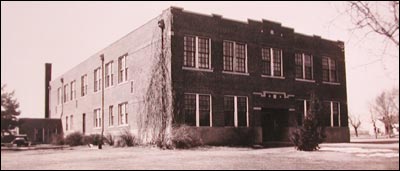
The high school that was open until 1956 sat in the block east of the present school building. The front faced east; the house in the background is the one owned for many years by Fred and Velma Schmidt. [November 6] Virgil Smith, who as you may remember grew up about three miles northwest of Pawnee Rock, went to high school in town around the time of World War II. Here are some of his memories: High school daysWhen I was in high school, there were no school buses and every family had to arrange transportation for their students. Leon Dirks had a Model A Ford that he drove to school and he picked up Art Bone and me. Art's family lived at the natural gas compressor station northwest of Pawnee Rock. Leon didn't go out for football or basketball, so I had to get home some other way. When the weather was good, Marvin Kroeker, who lived west of Pawnee Rock, and I often would walk home together part of the way after practice.
Often Leon [photographed with siblings Homer and Beverly] would check his traps on the way to school and one morning he had a skunk in one and got too close. When he got to school he was told to go back home and not come back until he smelled better. The old high school was in the block where the school bus garage was later built. There was a smaller building behind it that housed the furnaces and boilers for the steam heat radiators in the school. The only other building on the block was the Converse residence that later became my family's residence. A curved drive went in front of the school from one street to the other. There were two large pine trees on the north side and ivy growing on the south side. When you entered the school, there were steps going up to the balcony and hall and going down to the auditorium/gym, which was small with limited seating on the floor level and in the balcony for basketball games. The ceiling had three large beams across it and you had to be careful not to arch your basketball shots too much or it would hit the beam. There was no three-point shot nor shot clock, and some teams would play ball control to try to win. The football field had no grass and would grow up in weeds during the summer. Before the season started, it would be cleared off and graded smooth and lined. After a game or practice, you would look like you had been working in the field. We played such teams as Radium, Antrim, Zook, Hudson, Bison, and Hanston, which all had sizable enrollment, but most likely have all closed -- many before Pawnee Rock. We played six-man football, with three in on the line and three in the backfield. It was a high scoring game and I think that it was stopped when one team got forty points ahead, which often happened. Many farm boys took Agriculture and the girls took Home Ec. Two classes that I enjoyed were Biology and Journalism. We had a biology lab and had experiments and worked on some specimens. In Journalism, we published "The Papoose," the school paper, and worked on material for the annual. For "The Papoose," we would compose the articles and type them on stencils with a manual typewriter or put designs on them by hand with a template. Then they would be printed on paper with a hand-cranked mimeograph and assembled and stapled. The name of the paper and the school mascot probably would be regarded as derogatory by some groups today, but I think that they were adopted because they were symbols of people and things that were admired. I asked Virgil where the football field had been. He answered: The football field was about one and a half blocks north of the school and west in the field. I wish that more of your readers would send you their memories of people and events. When I read a letter on your site from someone that I haven't heard about for years, it's like a getting a personal letter and being reconnected. Who's in the photo?[November 6, part 2] A couple of correspondents wrote to identify at least one woman in the photo of the Pawnee Rock ladies in yesterday's Too Long in the Wind. I had asked whether Velda Pfister or her mother, Ella Foster, was in the photo. Kay Steed (whose photo is on today's homepage) wrote to say: "I'm fairly certain the lady in the front row, with the real dark dress on, is Grace (Cooper) Gilbert. Her daughter is June McCaughnahhay, who now lives in Larned and taught school there for many years. I don't see Ella Foster or Velda Pfister in the picture." Leon Miller wrote: "The only one of the women in the photo I recogize for sure is Grace Gilbert, who was front row, second from left. I think the woman directly behind her was a Bowman. Velda Pfister would have been much younger than these women. I would guess this photo was taken in the late 1930s or early 1940s. Velda would have been in her mid-30s at the time." Thanks to you both. It's nice to put a name to one of the faces. Connecting with Velda Pfister[November 4] Velda Foster Pfister's name still opens doors. Anita Byers and Leon Miller sent notes prompted by Kay Steed's mention of the 101-year-old Pawnee Rock native, and Don Ross sent a photo of the former Methodist Church, which Velda attended back in the day. The photo's on the homepage today. Anita Byers: "Her mother, Ella Foster, used to write the Pawnee Rock News weekly column for the Tiller. She would call everyone to see who had been where for dinner, had guests, or went to the big city, Hutchinson, to shop." Leon Miller: "Velda Pfister was one of my mother's dearest friends. They were both very active in the Pawnee Rock Methodist Church. Unfortunately, my mother found out she had inoperable cancer 50 years ago this month and died of that horrible disease in April 1958 at age 64." On another subject, Leon also wrote: "I too, am a proud Jayhawker sitting on cloud nine today, basking in the thrill of KU 76-nu 39!! During my days at KU, again 50 years ago, Nebraska was the doormat of the Big 8. Kansas didn't have the best football team but could always count on beating Nebraska, That changed starting in the mid- to late '60s." I'd appreciate it if you all would check out this photo, which supposedly is of Pawnee Rock ladies from early in the 20th century, and let me know whether Velda or Ella is among them. Do you recognize anyone else? 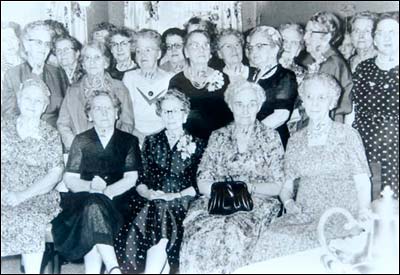
Velda Foster Pfister, 101[November 4] Kay Steed of Edgerton sent her regards Saturday, along with this note: "I just thought I'd mention to you one of Pawnee Rock's oldest living residents just turned 101 last week. My (a couple times removed) cousin, Velda Foster Pfister, celebrated her birthday on Oct. 26. She lives in Larned now but was born, raised, and lived most of her life in P.R. Oh, the things she must remember. "Her parents were Mel and Ella Foster. Ella was one of the original Cooper clan from which I am descended. Her mother lived to be 103, which makes me wonder what is in the water out there. "Anyway, just thought I'd pass that along. We are enjoying such a beautiful Ks. autumn." Dalton Keener, Santa Claus: The Great Bend Tribune's main story is about the Central Kansas Gathering of the Santas. Writer Jerry Buxton interviews Pawnee Rock's Dalton Keener, who has been dressing up as Santa for nine years. He's in the photo, too. The new world order: I sometimes feel bad for my K-State friends when the Wildcats lose at football. Same for pals from Oklahoma and Texas. But I never, ever shed a tear for the Nebraska Cornhuskers. All through my college days and up until a couple of years ago, the Huskers' football team beat the tar out of KU. Their fans -- a disquieting vision in white shoes, red pants, red jackets, and red-and-white teeth -- have been among the smuggest people ever to plop their bottoms onto stadium seats. That's what makes Saturday's KU victory over the Cornhuskers so satisfying. From now on the NU record book will show that the most points ever scored against the once-mighty Huskers was 76 on November 3, 2007, by their longtime patsy. The Huskers are vanquished for a year. Now if we could just do something about Nebraska's other irritating product -- the north wind. A photo I like: No. 59
This photo is from my days as a youngster, when making it up even eight feet off the ground provided a new and interesting vantage point. Our place had a half-dozen elms, so there was never a shortage of leaves and twigs. Good food: Joan Smith wrote: "As Leon Miller said, Bill Schroeder did own the grocery store. My parents rented a meat locker from him. The meat in Kansas, especially those quarters and sides of beef were wonderful. We have not had any as tasty since leaving Kansas." Life as we know it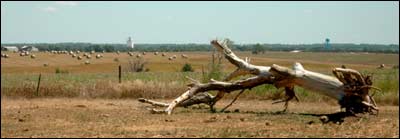
[November 2] The corpse of this elm (or locust) was lying in what used to be my Unruh grandparents' farmyard northwest of Pawnee Rock. Durward Smith, who bought the place, tore down the house after Grandma left and apparently tugged this tree out of the way so the remains of the house and outbuildings could be pushed into a trench in the old garden. Such is life. We'd like to think everything's always going to be the same; I'm sure this tree did when it set down roots about a hundred years ago after the farmhouse was built. Now the tree is just an awkward memento. It doesn't fit anywhere, and it's going to dry out, bake down, and return its nutrients to the soil. The woody dust will make a kazillion little bugs happy for their entire lives -- lives that are so brief that the age and circumstances of the tree must be inconceivable. Imagine philosophical insects asking, How did the tree get there? Who planted it? Is there life beyond the tree? Our lives are set on a larger stage, of course: the famously flat land, the endless sky, and the unceasing wind. Like the house that was raised and razed, like the tree that grew and fell, our Kansas will change. We won't see that happen. For us and our little bug partners, our Kansas is the eternal Kansas. Now let's get ready for winter
Pawnee Rock had appropriate weather for a fall festival. The north wind blew all day -- gusts to 40 mph -- and the temperature dropped fairly quickly at sundown. Fun with statistics: Anita Byers sent a link to a pretty cool site: ZipSkinny.com. Type in a ZIP code and you'll be rewarded with U.S. Census data in tables and pretty graphs. (It's the same basic stuff you'll find on PawneeRock.org's City Demographics page.) The neatest thing about the basic page is that compares Pawnee Rock data with data from nearby towns and cities: 67511 (Albert), 67519 (Belpre), 67520 (Bison), 67529 (Garfield), 67530 (Great Bend), 67550 (Larned), 67564 (Olmitz), 67575 (Rush Center), and 67576 (St. John). Some of the comparisons seem awkward -- when's the last time you mentioned Pawnee Rock and Rush Center in the same conversation? -- but there's a 20-space form you can fill in to set up your own choices to compare. For example, you could add Macksville (67557) and Otis (67565). If you're away, you can even compare Pawnee Rock to where you live now. Candy stand: Anita also suggested that Earl Allen Schmidt is the second, unidentified man in the Lions Club candy stand photo just added to the Photo Gallery. |
Sell itAdvertise here to an audience that's already interested in Pawnee Rock: Or tell someone happy birthday. Advertise on PawneeRock.org. |
|
|
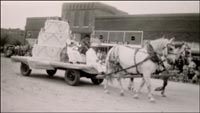
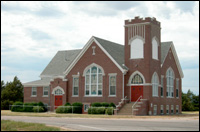 I will not say that our church members were tightfisted, although by no means were they -- or any Pawnee Rockers -- free with a dollar. But the church fit our needs as a place where we could congregate on Sundays and Christmas, where the Mission Workers could sew quilts on Wednesdays, and were we could gather to say goodbye to the dead and welcome the newly married.
I will not say that our church members were tightfisted, although by no means were they -- or any Pawnee Rockers -- free with a dollar. But the church fit our needs as a place where we could congregate on Sundays and Christmas, where the Mission Workers could sew quilts on Wednesdays, and were we could gather to say goodbye to the dead and welcome the newly married. Our unbeaten cow-state school was ready to become the top-ranked football team in the country if only it could beat what the TV networks were ballyhooing as archrival Missouri.
Our unbeaten cow-state school was ready to become the top-ranked football team in the country if only it could beat what the TV networks were ballyhooing as archrival Missouri.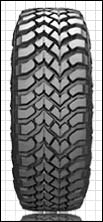 Of course, very few of us anymore haul the spare set of tires out of the garage and jack up the car to bolt them on. Nowadays we generally drive only on pavement and with fairly prissy all-season tires, although at least those of us in snowy climates get to buy studded tires because of the ice.
Of course, very few of us anymore haul the spare set of tires out of the garage and jack up the car to bolt them on. Nowadays we generally drive only on pavement and with fairly prissy all-season tires, although at least those of us in snowy climates get to buy studded tires because of the ice.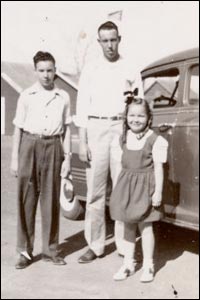 There seemed to be a lot of small animals around, such as 'possums, skunks,
badgers, etc. and it was common for rural teenage boys to set traps in the
burrows in fields and pastures to trap them and sell them for their pelts.
There was a place in Larned that bought all kinds of small animals. There would
be a mound of jack rabbits and piles of other animals. I think that they were
trucked some place to be skinned.
There seemed to be a lot of small animals around, such as 'possums, skunks,
badgers, etc. and it was common for rural teenage boys to set traps in the
burrows in fields and pastures to trap them and sell them for their pelts.
There was a place in Larned that bought all kinds of small animals. There would
be a mound of jack rabbits and piles of other animals. I think that they were
trucked some place to be skinned.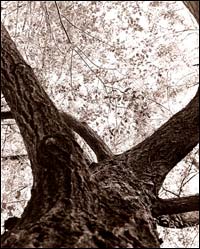 [November 3] Who among us hasn't lain under an elm and looked up into its rough branches and green canopy? Maybe we didn't chase any squirrels up one, but those are pretty good climbing trees if you can shinny your way up to the first branch.
[November 3] Who among us hasn't lain under an elm and looked up into its rough branches and green canopy? Maybe we didn't chase any squirrels up one, but those are pretty good climbing trees if you can shinny your way up to the first branch. [November 1] You're all responsible adults, so I know you didn't binge last night on leftover Halloween candy -- or on your kids' collection of goodies. I, however, am not as good as you.
[November 1] You're all responsible adults, so I know you didn't binge last night on leftover Halloween candy -- or on your kids' collection of goodies. I, however, am not as good as you.